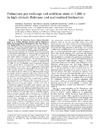Please use this identifier to cite or link to this item:
https://accedacris.ulpgc.es/jspui/handle/10553/6561
| Title: | Pulmonary gas exchange and acid-base state at 5,260 m in high-altitude Bolivians and acclimatized lowlanders | Authors: | Wagner, P.D. Araoz, M. Boushel, R. Calbet, JAL Jessen, Birguitte Radegran, Goran Spielvogel, Hilde Sondergaard, H. Wagner, Harrieth Saltin, Bengt |
UNESCO Clasification: | 241106 Fisiología del ejercicio | Keywords: | Hypoxia Cardiac output VO2max Altitude Exercise |
Issue Date: | 2002 | Journal: | Journal of Applied Physiology | Abstract: | Pulmonary gas exchange and acid-base state were compared in nine Danish lowlanders (L) acclimatized to 5,260 m for 9 wk and seven native Bolivian residents (N) of La Paz (altitude 3,600-4,100 m) brought acutely to this altitude. We evaluated normalcy of arterial pH and assessed pulmonary gas exchange and acid-base balance at rest and during peak exercise when breathing room air and 55% O2. Despite 9 wk at 5,260 m and considerable renal bicarbonate excretion (arterial plasma HCO3- concentration = 15.1 meq/l), resting arterial pH in L was 7.48 +/- 0.007 (significantly greater than 7.40). On the other hand, arterial pH in N was only 7.43 +/- 0.004 (despite arterial O2 saturation of 77%) after ascent from 3,600-4,100 to 5,260 m in 2 h. Maximal power output was similar in the two groups breathing air, whereas on 55% O2 only L showed a significant increase. During exercise in air, arterial PCO2 was 8 Torr lower in L than in N (P < 0.001), yet PO2 was the same such that, at maximal O2 uptake, alveolar-arterial PO2 difference was lower in N (5.3 +/- 1.3 Torr) than in L (10.5 +/- 0.8 Torr), P = 0.004. Calculated O2 diffusing capacity was 40% higher in N than in L and, if referenced to maximal hyperoxic work, capacity was 73% greater in N. Buffering of lactic acid was greater in N, with 20% less increase in base deficit per millimole per liter rise in lactate. These data show in L persistent alkalosis even after 9 wk at 5,260 m. In N, the data show 1) insignificant reduction in exercise capacity when breathing air at 5,260 m compared with breathing 55% O2; 2) very little ventilatory response to acute hypoxemia (judged by arterial pH and arterial PCO2 responses to hyperoxia); 3) during exercise, greater pulmonary diffusing capacity than in L, allowing maintenance of arterial PO2 despite lower ventilation; and 4) better buffering of lactic acid. These results support and extend similar observations concerning adaptation in lung function in these and other high-altitude native groups previously performed at much lower altitudes. | URI: | https://accedacris.ulpgc.es/handle/10553/6561 | ISSN: | 8750-7587 | DOI: | 10.1152/japplphysiol.00093.2001 | Source: | Journal Of Applied Physiology[ISSN 8750-7587],v. 92 (4), p. 1393-1400 |
| Appears in Collections: | Artículos |
Show full item record
SCOPUSTM
Citations
84
checked on Jun 8, 2025
WEB OF SCIENCETM
Citations
78
checked on Jun 8, 2025
Page view(s)
76
checked on May 18, 2024
Download(s)
319
checked on May 18, 2024
Google ScholarTM
Check
Altmetric
Share
Export metadata
This item is licensed under a Creative Commons License

